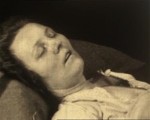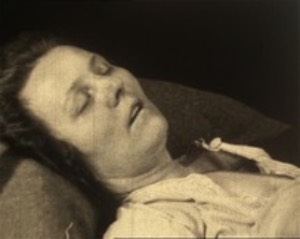
 Screenshot from Friedrich Heinrich Lewy's (1885-1950) film, Acute encephalitis lethargica, Germany, 1925 © Wellcome Collection.
Screenshot from Friedrich Heinrich Lewy's (1885-1950) film, Acute encephalitis lethargica, Germany, 1925 © Wellcome Collection.
“The patient falls asleep where they stand or are sitting, even in absolutely uncomfortable positions. [...] They are oriented, drowsy but clear [...] ; as soon as they are left by themselves, they fall asleep again”. That is how Constantin von Economo, an Austro-Hungarian neurologist, characterises a peculiar disease that he describes for the first time in May 10th, 1917 in “Wiener klinische Wochenschrift”. Since the end of 1916, von Economo has examined at the Vienna psychiatrist clinic several patients with rather identical symptoms, but none of them corresponded to known diagnosis patterns. There were many reasons to affirm that it was a disease in its own right : the encephalitis lethargica (EL), also called epidemic encephalitis or European sleeping sickness.
Spreading on several continents from 1917 until 1925, this disease has probably hit between 500 000 and 1 million people. Its symptoms were mysterious : patients suffer from headaches, conscience troubles, in some cases fever, paralysies and deliriums, before entering a state of somnolence during which they seem to be sleeping but are still conscious of their environment. In the following weeks, death occurs in one third of the cases, another third of the patients get cured and the last third suffers from symptoms which resemble advanced Parkinson’s disease.
When von Economo examined the disease in 1917, he was not the first to describe these symptoms. Some weeks earlier, Jean-René Cruchet, a French neuropsychiatrist on the front, described having treated soldiers suffering from similar symptoms. In the following years, a struggle broke out between von Economo and Cruchet, both claiming the discovery of the disease.
The disease spread faster from 1917 onward. In 1917, it was already declared an official epidemic in Vienne, while in France and in Great-Britain it became an official epidemic in 1918. In September and October 1918, it arrived at New York. From 1919, it also struck Canada, Central America and India before attaining a peak in Europe in 1921. In total in France, the physician Netter estimated that there were around 10 000 cases until the disease disappeared in Europe around 1925. The EL existed sporadically until the 1930s.
The question on why the disease disappeared as quickly as it appeared nevertheless remains open - just like a number of other questions on the origins of the EL, its mode of spreading and its cure. We estimate today that it is a viral disease, perhaps even caused by the Spanish flu. But studies which have proven a link with the Spanish flu are as numerous as those which refute it, meaning that we cannot exclude either a toxicological origin nor an autoimmune origin. However, without knowing the source of the disease, it is obviously impossible to know how it spreads, and even less how it can be cured.
How to explain this lack of knowledge ? Granted, medecine of the time did not have yet the means that we currently have, but more importantly, the Great War and nationalisms prevented any interstate talk, which, consequently, significantly hindered medical research. Although only a few weeks separate the publication of Cruchet and von Economo, the Great War made it so that neither Cruchet nor von Economo directly learn from the other’s work ; the cross-border scientific exchange was almost non-existent and the enemy’s newspapers forbidden. Added that von Economo’s article was written in German in a period dominated by hatred towards the Germanic neighbour.
Even after the war, nationalisms continued to hinder the research on the encephalitis lethargica. For instance, during the 1920s, German physician Felix Stern became one of the leading scientists of the disease. At the time, nothing could prevent him from continuing to study it except being Jew. When the Nazis come to power, he had a ban on practising his occupation and commited suicide in 1942 a little before he had to be deported.
Still today, the EL remains largely unknown to the general public. More than the Spanish flu, it is a disease which is “buried under the memorial deluge” of the Great War, still in the shade of political events. Thus, the EL has become a real “forgotten epidemic” that neither the apparition of about 80 new sporadic cases since 1930, nor the book “Awakenings” and its eponymous film, telling the story of several victims of encephalitis lethargica, could have taken out from forgetfulness and mystery.
Read more in the dictionary : neurodiversity - LSD - Nostalgia - Female delirium
Read the paper in French : encéphalite
Références :
Laura Spinney, La grande tueuse. Comment la grippe espagnole a changé le monde, Albin Michel, 2018.
Joel A. Vilensky, Encephalitis lethargica: During and after the Epidemic, Oxford University Press, 2011.
To quote this paper : Jonas Althoff, “Encephalitis”, in Hervé Guillemain (ed.), DicoPolHiS, Le Mans Université, 2023.